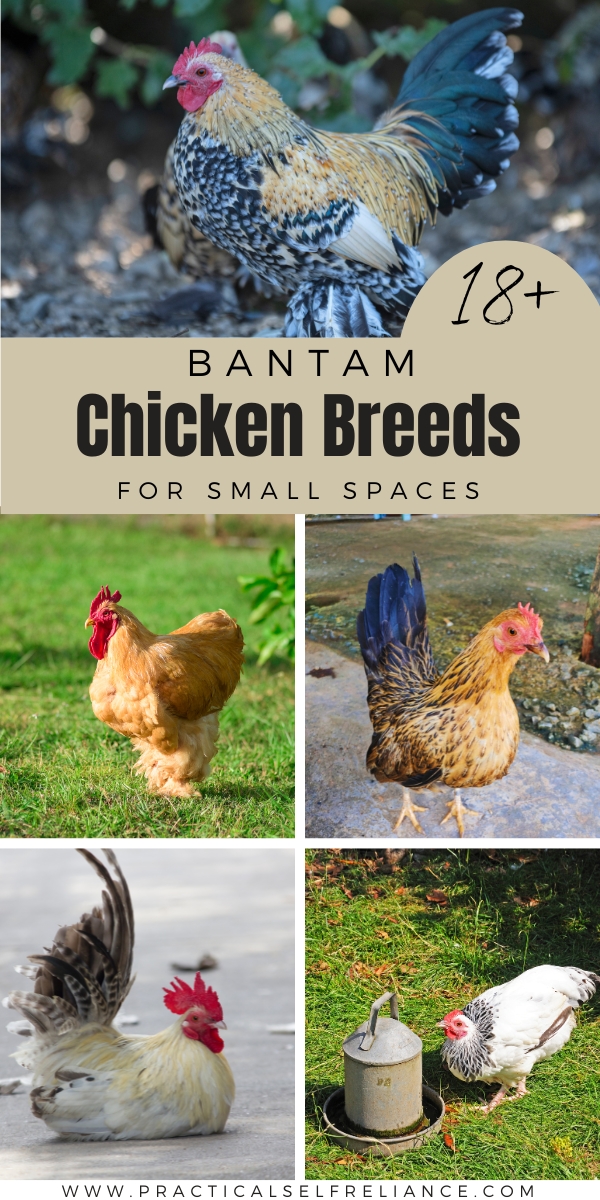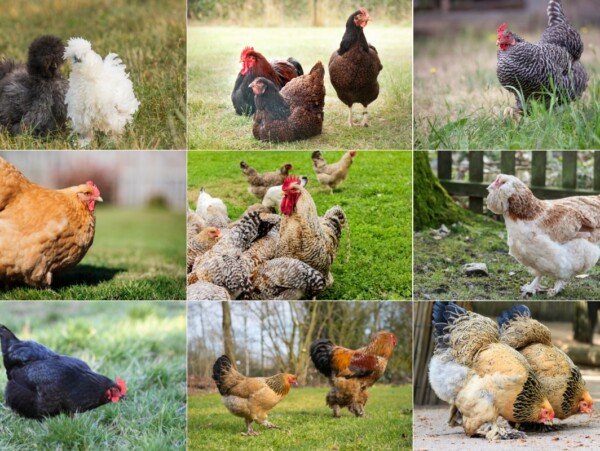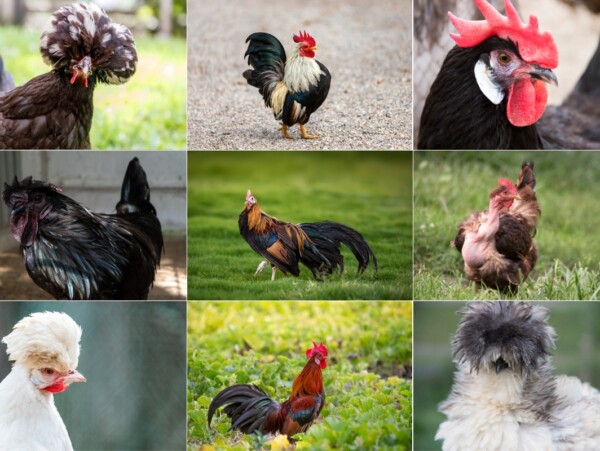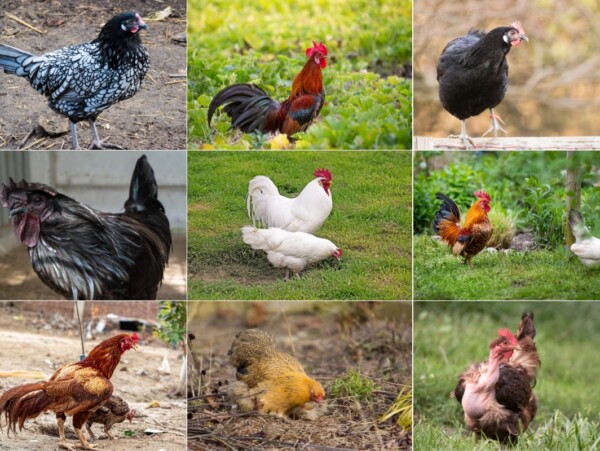Affiliate disclosure: This post may contain affiliate links. Please see our Privacy Policy.
Bantam Chicken Breeds are perfect for small spaces, and they’re some of the best options for a small suburban backyard coop.
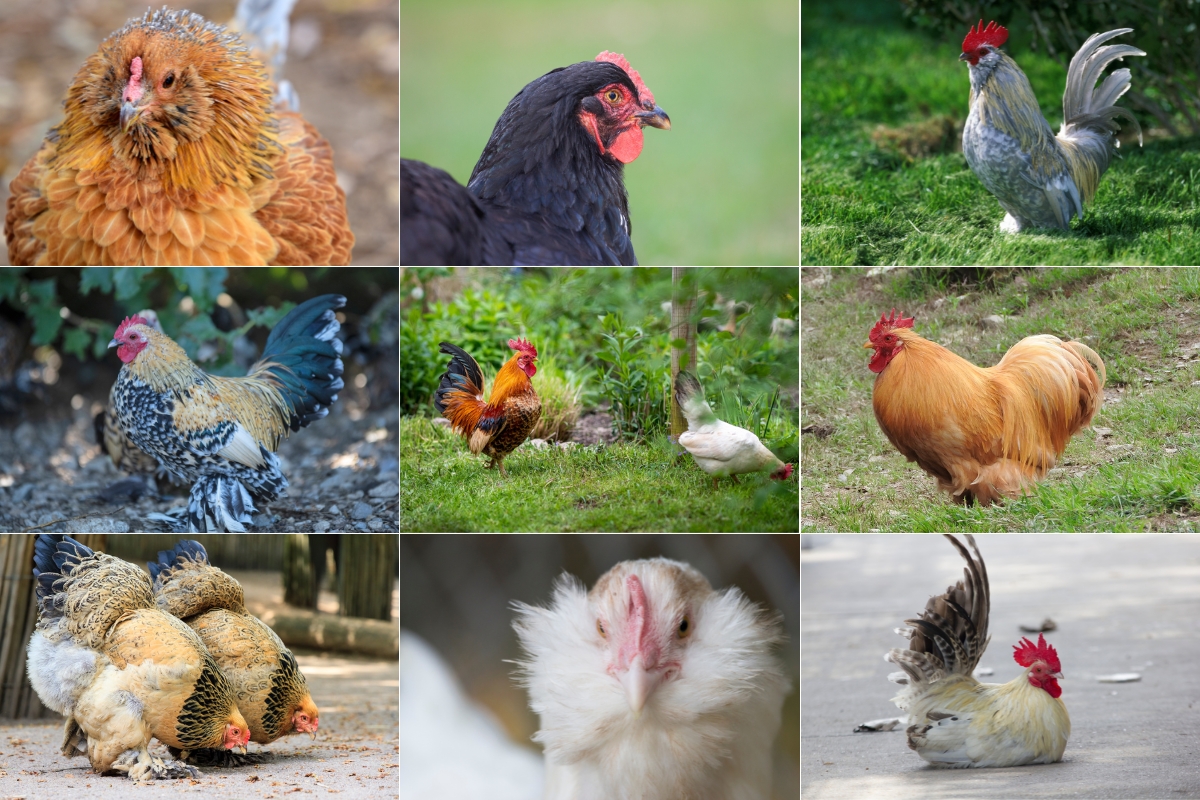
Table of Contents
- List of Bantam Chicken Breeds
- Ameraucana Bantam
- Australorp Bantam
- Barbu d’Anvers
- Barbu d’Uccle
- Booted Bantam
- Brahma Bantam
- Cochin Bantam
- Dutch Bantam
- Faverolles Bantam
- Japanese Bantam
- Nankin Bantam
- Orpington Bantam
- Plymouth Rock Bantam
- Polish Bantam
- Rhode Island Red Bantam
- Rosecomb Bantam
- Serama
- Silkie Bantam
- Sussex Bantam
- Wyandotte Bantam
- Chicken Breed Guides
This article is written by Rea Yoh, a freelance writer who grew up in rural Illinois, raising backyard chickens. She graduated with honors in Biology and Science, Technology, and Society from Brown University, and her background in research helps her get to the heart of any question. She has a passion for animals, the environment, and sustainable living.
If you’ve been around Bantam chickens, you know that good things come in small packages. Bantams, by definition, are any small variety of fowl. Specifically among chickens, bantams are one-half to two-thirds the size of a regular-sized bird. Bantams themselves are not a breed of chicken. While a lot of bantam chickens are smaller versions of large breeds, like Orpingtons, other small chickens are what we call “true bantams”, or chickens that only come in a small size, like Nankins. The three classifications of bantam chickens are true bantams, which are bantams with no large counterpart; miniaturized bantams, which are bantams that originate from a standard-sized breed that retain many of the same characteristics; and developed bantams, which are small birds that have been developed into breeds over time.
The American Bantam Association, or ABA, was founded in 1914 to promote bantam breeds. They are separate from the American Poultry Association, so not all of the same breeds are recognized by the ABA and APA. There are six classes of bantams accepted by the American Poultry Association: Modern Game, Game, Single Comb Clean Legged, Rose Comb Clean Legged, Feather Legged, All Other Comb Clean Legged.
There are lots of reasons why you might consider owning a bantam chicken. Small chickens generally eat less than their larger counterparts, are easier to handle, and don’t need as much space. The last point is especially important for people who live in apartments or have tiny yards–you don’t get to miss out on the fun of owning chickens if space is an issue! Limited space is no problem if you have the right breeds of chicken, which I’ll help you identify in this article.
These pint-sized poultry may be small in stature, but they’re just as wonderful as their big brethren. They’re sure to turn heads, whether they’re in your backyard or in your house. If you’re interested about learning more about the best bantam breeds for small spaces, read on!
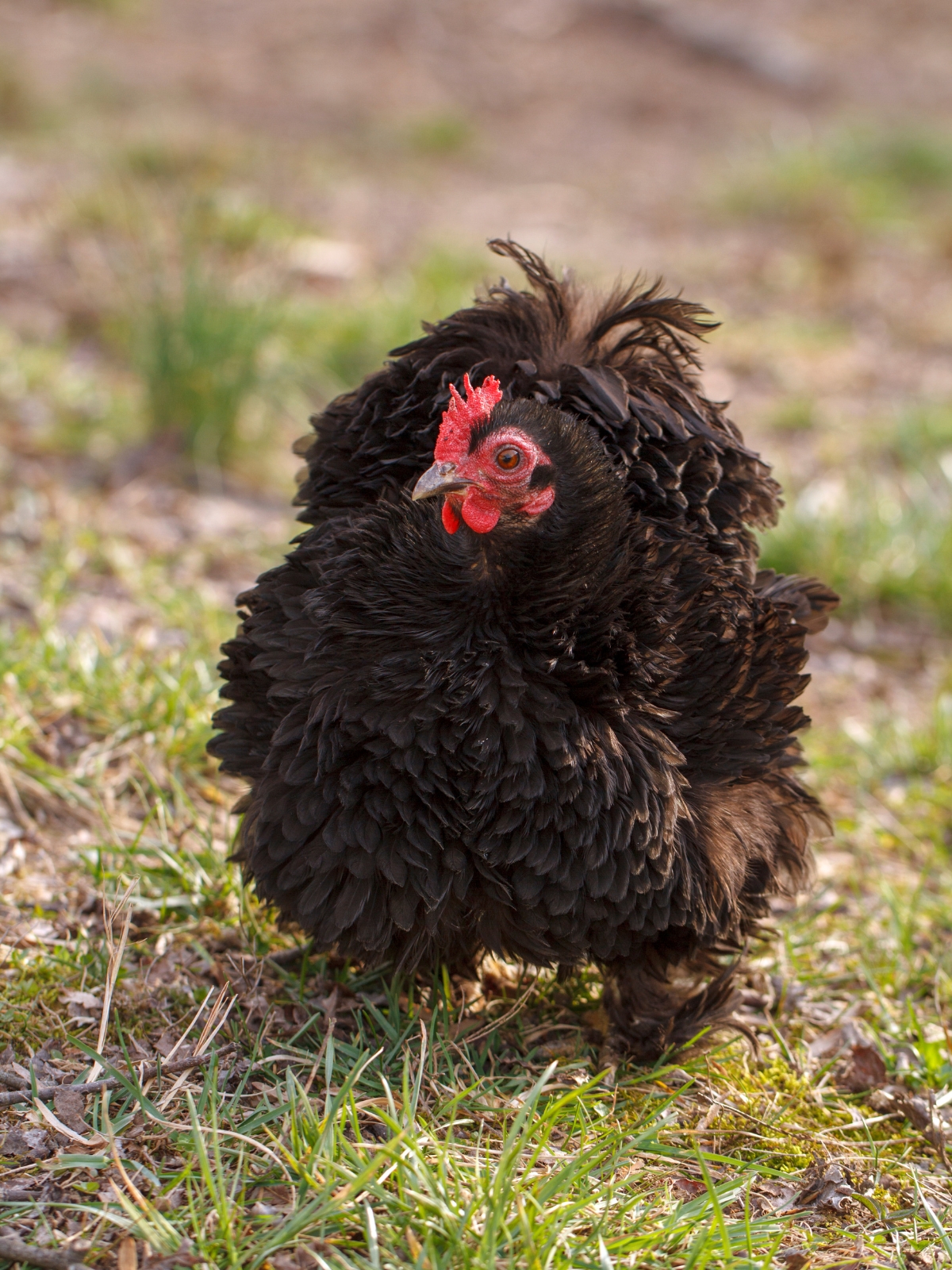
List of Bantam Chicken Breeds
- Ameraucana Bantam
- Australorp Bantam
- Barbu d’Anvers
- Barbu d’Uccle
- Booted Bantams
- Brahma Bantam
- Cochin Bantam
- Dutch Bantam
- Japanese Bantam
- Nankin
- Orpington Bantam
- Pekin Bantam
- Plymouth Rock Bantam
- Polish Bantam
- Serama
- Silkie Bantam
- Sussex Bantam
- Wyandotte Bantam
Ameraucana Bantam
If you want colorful eggs but don’t have enough room for a flock of full-sized birds, you’re in luck! The Ameraucana, treasured for its ability to lay eggs in shades of blue, green, or even pink depending on the strain, comes in a bantam variety.
Large Ameraucanas lay up to 200 eggs per year, and bantam Ameraucanas are just as prolific, producing 150-200 per year. In terms of personality, bantam Ameraucanas are very bright, curious birds.
They like having space to explore, but if you have a smaller area, they’re perfectly content. They’re a very easy breed of bantam chicken to keep.
- Breed Name: Ameraucana (Pronounced uh-meh-raw-kaw-nuh)
- Breed Type: Layer, ornamental
- Temperament: Curious, active, good foragers
- Size: Hens 1.75 lbs, roosters 1.85 lbs
- Eggs Per Year: 150-200
- Egg Size: Small
- Egg Color: Blue, with occasional green tints
- Feather Type: Standard, with trim muffs and clean legs
- Comb Type: Pea Comb
- Hardiness: Cold hardy, and heat tolerant
- Lifespan: 7-8 years
- Time To Maturity: 20 to 24 Weeks
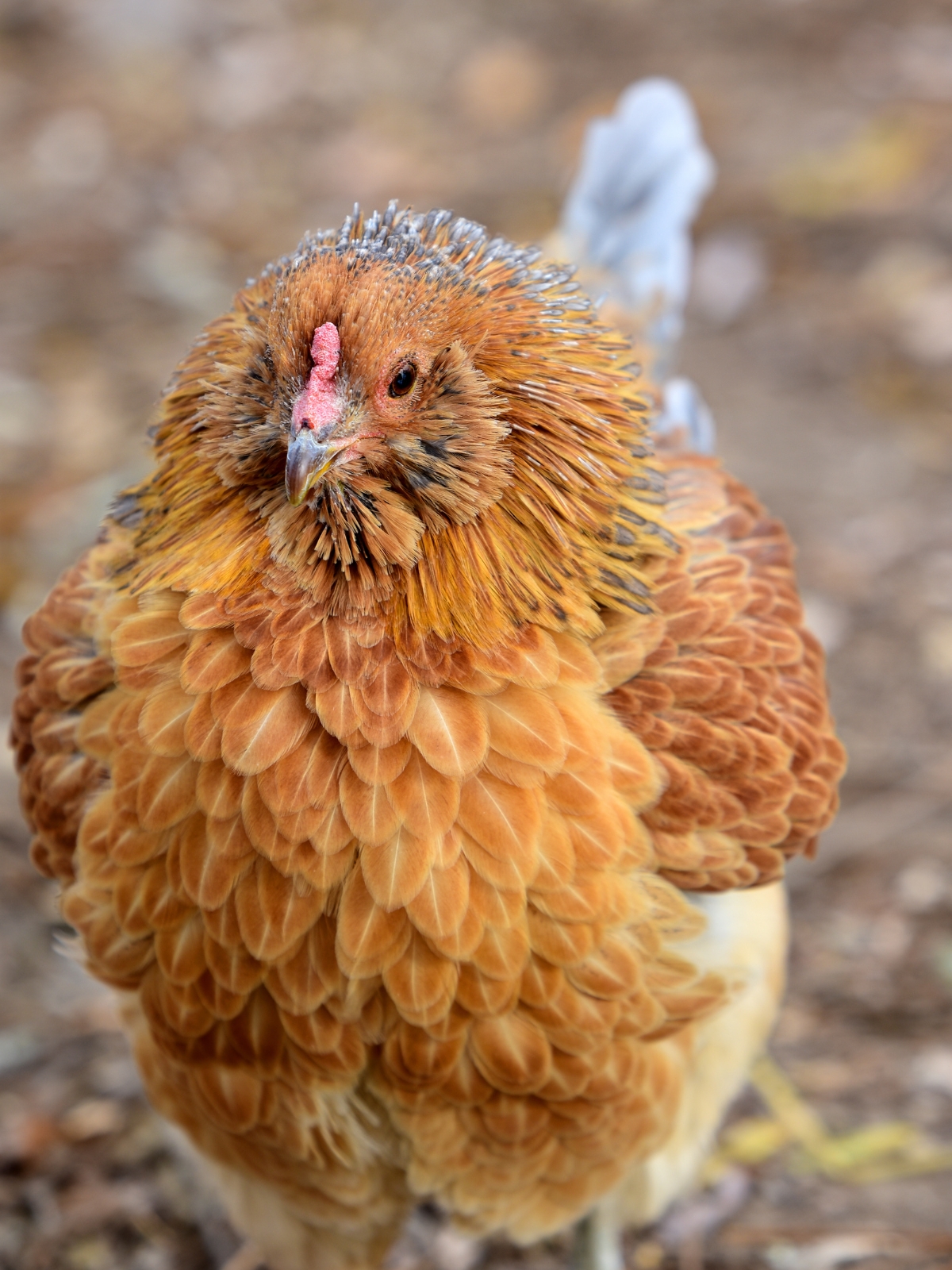
Australorp Bantam
Australorp bantams are the miniaturized version of the Australorp. This chicken was bred in Australia as a cross between the ever-popular Orpington and several other productive layer breeds, like the Rhode Island Red.
Australorps are famous for being one of the best layers out there. For a while, an Australorp held the world record for most eggs laid by a single hen in a year, at a whopping 364 eggs in 365 days.
The bantam Australorp is also a great layer, and probably the best bantam chicken for eggs, laying up to 250 per year in the right conditions! Not only are they great at producing eggs, bantam Australorps are just as friendly, gentle, and easygoing as a regular Australorp.
They’re very happy in small spaces and not keen to fly when compared to other small birds, making them one of the best bantam breeds to have for first-time owners.
- Breed Name: Australorp bantam
- Breed Type: Layer, ornamental
- Temperament: Friendly, gentle, easygoing
- Size: Hens 1.7 lbs, roosters 2.1 lbs
- Eggs Per Year: 200-250
- Egg Size: Small
- Egg Color: Light brown
- Feather Type: Standard with clean legs
- Comb Type: Single comb
- Hardiness: Cold Hardy and Heat Tolerant
- Lifespan: 6-10 years
- Time To Maturity: 20 to 24 Weeks
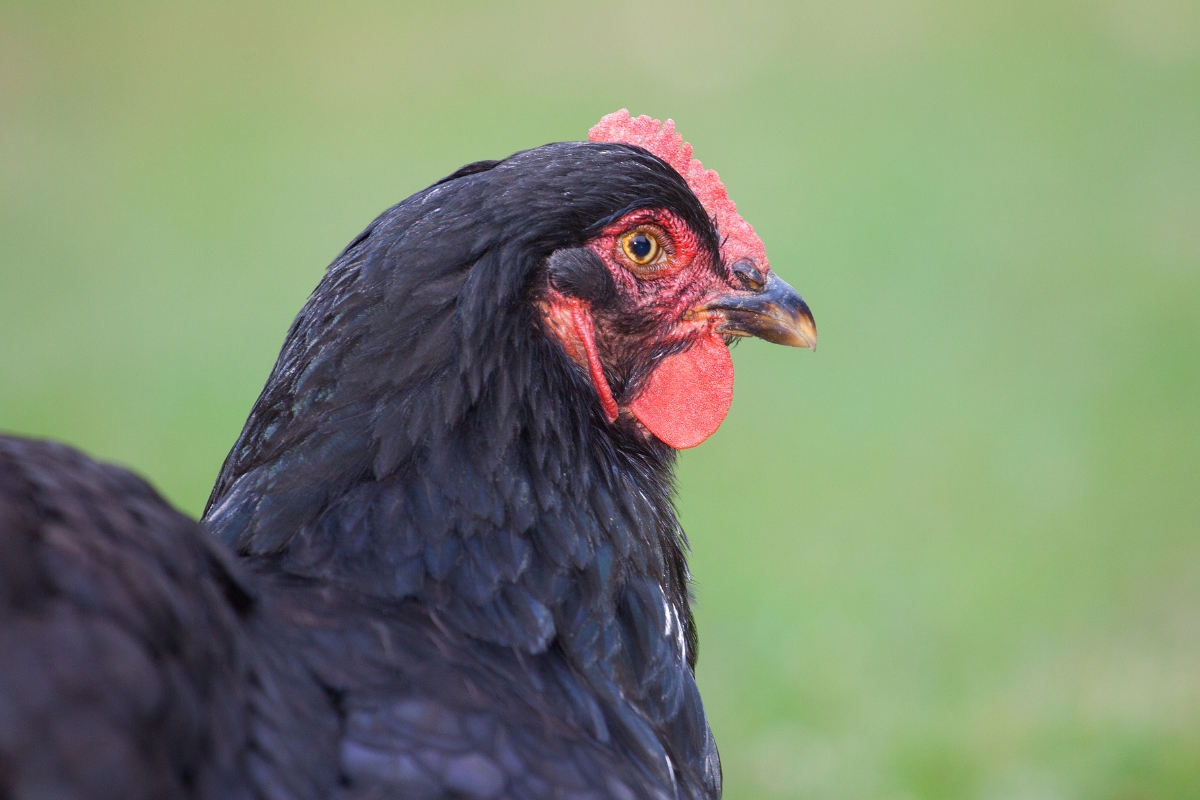
Barbu d’Anvers
The Barbu d’Anvers is one of the oldest bantam breeds that exists today. Historians trace its roots to the Belgian province of Antwerp, likely originating from small bearded chickens in the Netherlands. The Barbu d’Anvers was accepted in 1949 by the American Poultry Association.
Its lengthy legacy makes the Barbu d’Anvers the origin for a lot of other true bantam breeds, like the Barbu d’Uccle. It’s also the only bantam breed that isn’t at risk of going extinct, showing its popularity throughout the years.
The Barbu d’Anvers is an ornamental bird and loves to show off its large beard and glorious plumage. Barbu d’Anvers hens aren’t the best at laying, producing around 100 creamy white eggs per year from around 20 weeks old.
For the most part, Barbu d’Anvers are good pets, especially if you like fluffy little birds. However, roosters are known to be a bit feisty. They’re quite active and energetic, and they can be flighty at times. Barbu d’Anvers chickens still make great companions in a small space.
- Breed Name: Barbu d’Anvers, (Pronounced bar-BOO dann-VAIR), Antwerp Belgian Bantam
- Breed Type: Ornamental
- Temperament: Energetic, friendly, active. Roosters can be aggressive.
- Size: Hens 1.3 lbs, roosters 1.5 lbs
- Eggs Per Year: 100-150
- Egg Size: Small
- Egg Color: Cream and white
- Feather Type: Standard, with muffs and clean legs
- Comb Type: Rose comb
- Hardiness: Cold hardy and heat tolerant
- Lifespan: 7-8 years
- Time To Maturity: 19 to 24 Weeks
Barbu d’Uccle
Also, known as the Belgian d’Uccle, the bearded, booted Barbu d’Uccle is one of the most gorgeous bantam breeds out there. A cross between the Sabelpoot and a Barbu D’anvers, the Barbu d’Uccle is one of the many true bantams created in Belgium. The breeders wanted a chicken with both a beard and feathered legs. Barbu d’Uccle come in a rainbow of patterns and colors.
The first Barbu d’Uccles were of the millefleur variety, with bright orange feathers interlaced with white and black. Some other colors of Belgian d’Uccle accepted by the APA are porcelain, black, golden neck, mottled, self blue, and white. They’re sure to draw lots of attention with their flashy feathers.
Barbu d’Uccle are great bantams to have as pets– they’re relatively quiet, extremely friendly, and intelligent. You can train your Barbu d’Uccle to fly onto your lap or shoulder!
While no bantam breed is kept for egg laying, Barbu d’Uccle lay a very reasonable number, up to 150 per year. They also have a tendency to go broody. Overall, the Barbu d’Uccle is one of the best breeds for small spaces if you want a friendly, cuddly chicken!
- Breed Name: Barbu d’Uccle, Belgian d’Uccle (Pronounced: bar-BOO doo-CLAY)
- Breed Type: Ornamental
- Temperament: Friendly, intelligent, gentle
- Size: Hens 1.3 lbs, Roosters 1.6 lbs
- Eggs Per Year: 100-150
- Egg Size: Small
- Egg Color: Cream
- Feather Type: Standard, with muffs and feathered legs
- Comb Type: Single Comb
- Hardiness: Cold Hardy and Heat Tolerant
- Lifespan: 7-8 years
- Time To Maturity: 20 to 24 Weeks

Booted Bantam
Like the name might imply, Booted Bantams look like they’re wearing boots. Feathered from head to toe, Booted Bantams are one of the many true bantams that originated in Belgium. Mixed with other feather-legged breeds like the Belgian Bantam, Dutch Sabelpoot, and bantams from Britain, the Booted Bantam has a long and disputed history that dates back to the 1600s.
It’s a rare bird today, but its popularity is on the rise, as it makes a lovely heritage breed. Booted Bantams are perfect if you want an easygoing bird with personality and charm. Booted Bantams come in a staggering number of colors, over 20!
Another reason to get a Booted Bantam, aside from their personalities and ornamental qualities, is their ability to lay eggs. Laying about 120 eggs per year is no small feat for a bantam breed.
- Breed Name: Booted Bantam, Dutch Sabelpoot
- Breed Type: Ornamental
- Temperament: Friendly, active, sweet
- Size: Hens 1.7 oz, roosters 1.9 lbs
- Eggs Per Year: 120
- Egg Size: Small
- Egg Color: White
- Feather Type: Standard with muffs and feathered legs
- Comb Type: Single
- Hardiness: Cold hardy, and heat tolerant
- Lifespan: Up to 10 years
- Time To Maturity: 20 to 24 Weeks
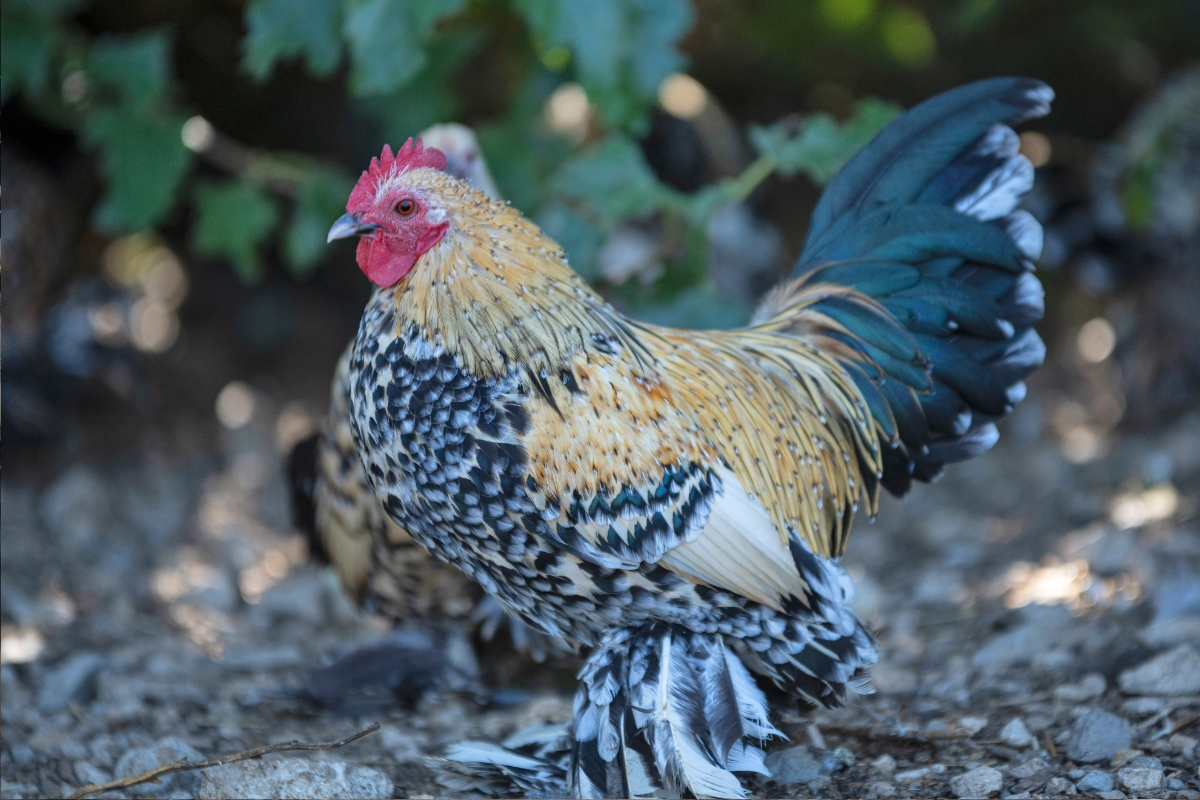
Brahma Bantam
Maybe you dream of owning one of the largest breeds of chicken, but you don’t have much of a yard… Good thing Brahmas come in a bantam variety! A relatively new creation, the Brahma bantam takes all of the great qualities of its large counterpart into a much more manageable size, which is perfect for people who want an easygoing chicken but have little space.
Brahmas are one of the best bantam breeds for beginners. They’re extremely friendly and gentle, requiring little activity and space. Bantam Brahmas aren’t as good for meat as a large Brahma but are surprisingly great layers, averaging around 150 eggs per year in good conditions.
This is a best-case scenario, though–bantam Brahmas are very broody, and they’re very likely to sit. On top of their egg production, bantam Brahmas don’t eat as much as the large version, saving you lots of money that would have otherwise gone towards feeding them. Happy in confinement or in a yard, bantam Brahmas are a wonderful addition to a home of any size.
- Breed Name: Brahma
- Breed Type: Ornamental, layer, brooder
- Temperament: Gentle, easygoing, affectionate
- Size: Hens 2 lbs, roosters 3 lbs.
- Eggs Per Year: 100-150
- Egg Size: Small
- Egg Color: Light brown
- Feather Type: Feathered legs
- Comb Type: Pea Comb
- Hardiness: Cold hardy, and heat tolerant
- Lifespan: 7-10 years
- Time To Maturity: 19 Weeks
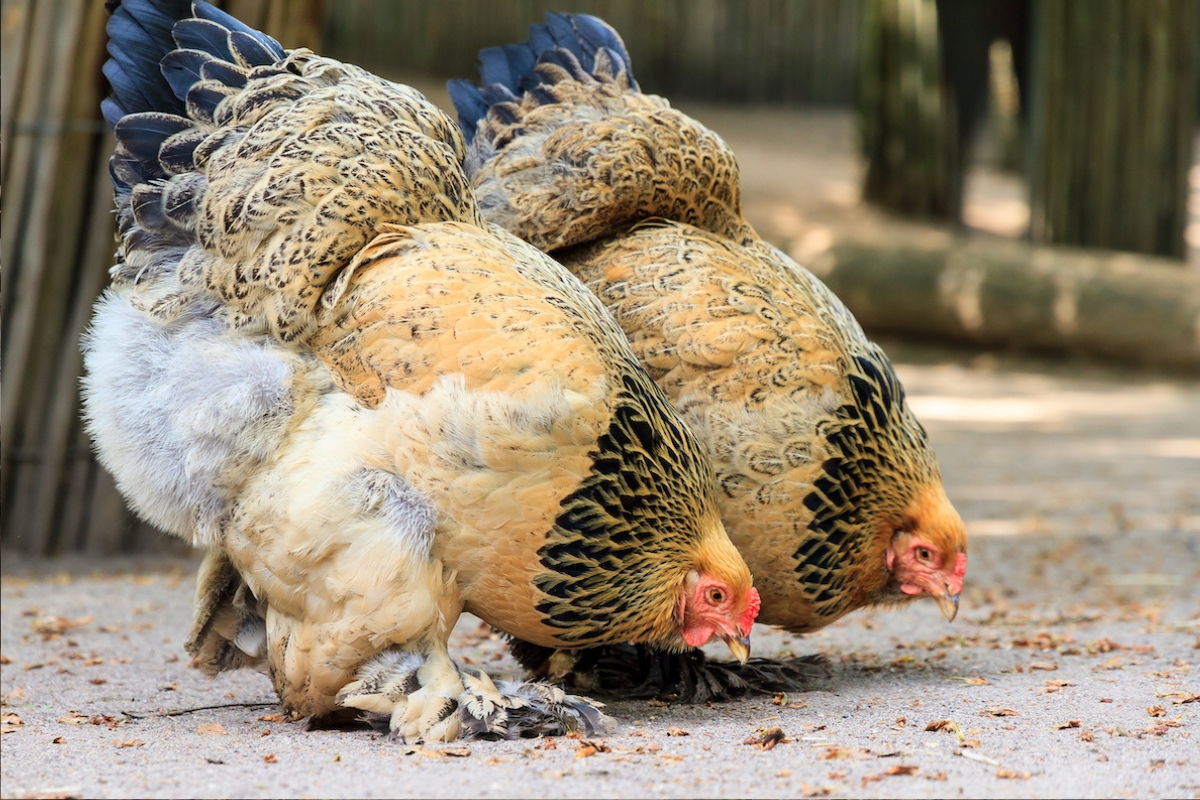
Cochin Bantam
Despite sharing the name of another breed of chicken, Cochin Bantams are distinct from Cochins. They’re also known as Pekins, and this name is commonly used in Europe. Bantam cochins are one of the best-known bantams out there and perfect if you want a small, cuddly chicken that will happily live in any space. They aren’t flighty at all and do well in confinement.
Cochin bantams are covered in soft, fluffy feathers from head to toe, making them look bigger than they actually are, and they’re as cuddly as they look. Cochin bantams are sweet little birds, forming strong bonds with their owners. They’re easily trained to be lap chickens and are perfectly fine with being handled. Kids and bantam Cochins get along very well! Cochin bantams are also great brooders, and they’re very happy to sit on some eggs to hatch.
- Breed Name: Cochin, Pekin
- Breed Type: Ornamental, brooder
- Temperament: Sweet, friendly, affectionate
- Size: Hens 1.6 lbs, roosters 1.9 lbs
- Eggs Per Year: 100-150
- Egg Size: Small
- Egg Color: Cream or light brown
- Feather Type: Feathered legs
- Comb Type: Single comb
- Hardiness: Decently hardy
- Lifespan: 7-10 years
- Time To Maturity: 5-6 months
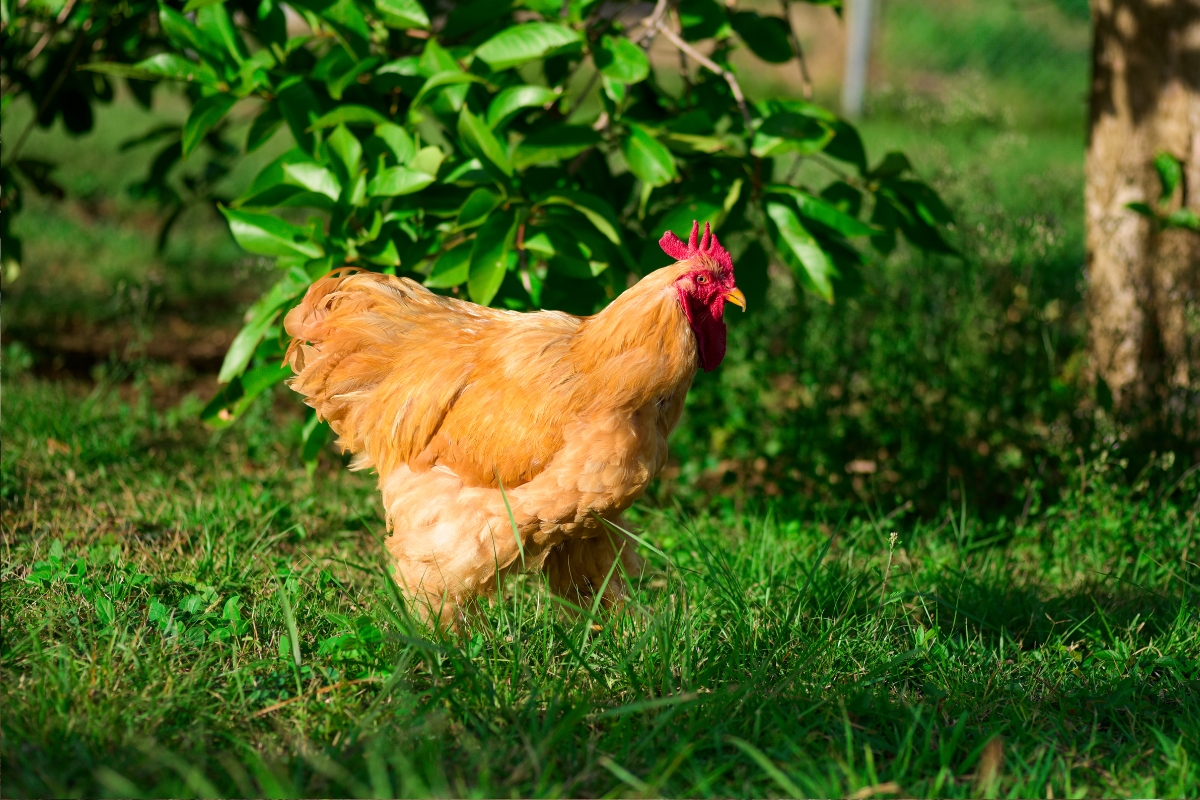
Dutch Bantam
Bantams are small– we’ve established that. If you’re extra-short on space, the Dutch bantam might be for you. Dutch chickens are among the smallest bantam breeds of chicken at just over one pound. They’ve been around for ages, brought over to Holland by explorers to Bantam Island in Indonesia in the 1600s. In the 1880s, they became an officially recognized breed in the Netherlands.
Dutch chickens are eye-catching–they have a dignified, stately appearance and come in gorgeous, flashy colors. Their small size makes them good fliers, as their wings are quite large in comparison to their bodies. They’re friendly birds, but can be a bit flighty. Their compact size ultimately makes them a good breed to have with limited space.
- Breed Name: Dutch Bantam
- Breed Type: Ornamental, brooder
- Temperament: Friendly, calm, active
- Size: Hens 1.1 lbs. and Roosters 1.2 lbs
- Eggs Per Year: 80-160
- Egg Size: Small
- Egg Color: White or cream
- Feather Type: Standard, with clean legs
- Comb Type: Single comb
- Hardiness: Cold hardy
- Lifespan: 4-8 years
- Time To Maturity: 20 to 24 Weeks
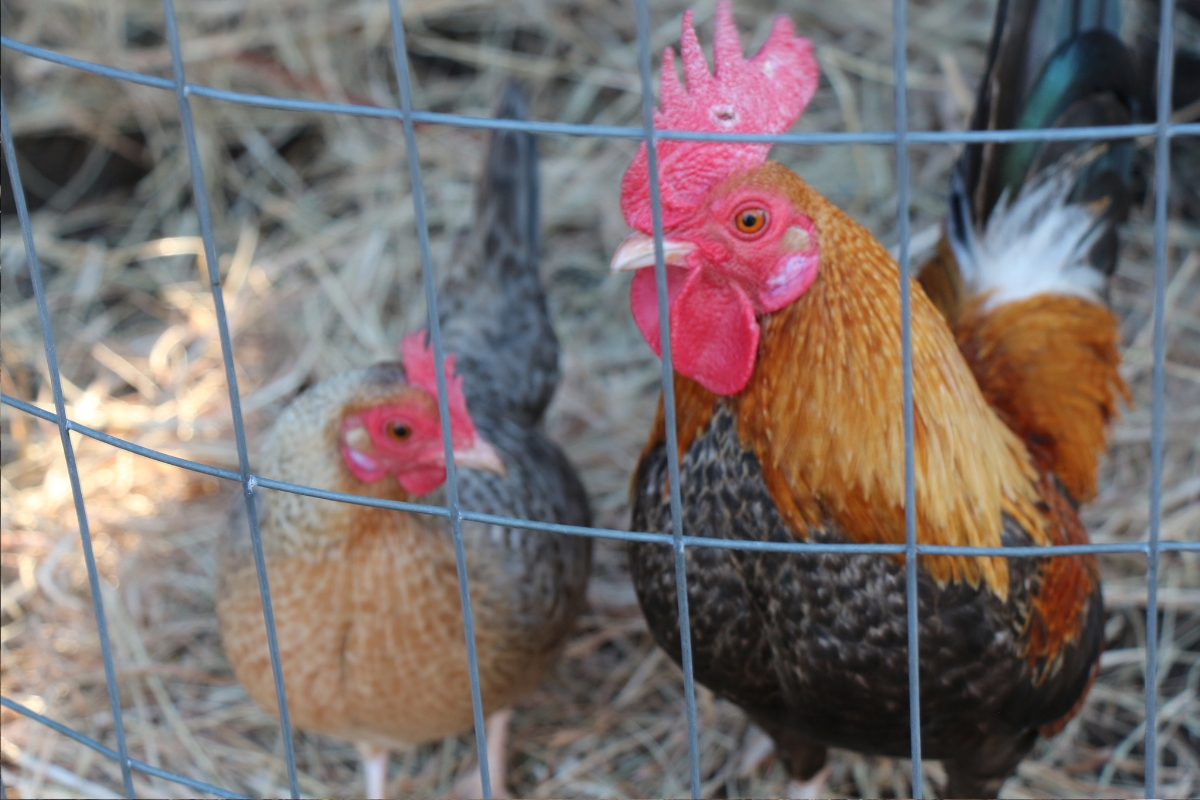
Faverolles Bantam
Our giant, fluffy, beloved Faverolles comes in a mini variety! Bantam Faverolles bring all of the great qualities of their big bird counterparts into a slightly smaller, just-as-fluffy package. Faverolles have a very particular appearance, with huge amounts of fluff, feathered feet, and feet with five toes, and bantam Faverolles are a very easygoing ornamental breed.
They’re easily converted into lap chickens, happy to be held, and form strong bonds with their owners. These energetic chickens are happy to put on a show and love attention. If you’re interested in Faverolles, which you can read about here, but have little space, know that a bantam version will suit you just as well! They don’t need much space to roam and are low maintenance.
- Breed Name: Faverolles Bantam
- Breed Type: Ornamental, layer
- Temperament: Active, friendly
- Size: Hens 1.6 lbs, roosters 1.8 lbs
- Eggs Per Year: 150-200
- Egg Size: Small
- Egg Color: Light brown or cream
- Feather Type: Standard, feathered legs, bearded
- Comb Type: Single
- Hardiness: Cold hardy
- Lifespan: 5-7 years
- Time To Maturity: 20 Weeks

Japanese Bantam
An absolute showstopper, Japanese bantam chickens have a very striking appearance. These short-legged, petite birds have huge combs and tails and come in vibrant colors. They’re loved as ornamental chickens, strutting around proudly and owning their space. They’re not good layers, only producing about one egg per week, but are very happy as brooders.
Japanese bantam hens invest a lot of love into hatching, but due to a lethal gene, very few Japanese bantam chicks hatch, so you might want to give them the eggs from another breed of chicken. A Japanese Bantam’s affection extends to humans– Japanese bantams are very affectionate and make great company. You can train them to fly onto your shoulder!
- Breed Name: Japanese Bantam, Chabo
- Breed Type: Ornamental, brooder
- Temperament: Curious, active, friendly
- Size: Hens 1.5 lbs, roosters 1.75 lbs
- Eggs Per Year: 60-100
- Egg Size: Small
- Egg Color: White or cream
- Feather Type: Standard, with clean legs
- Comb Type: Single
- Hardiness: Cold hardy and heat tolerant
- Lifespan: 8-10 years
- Time To Maturity: 16 to 20 Weeks
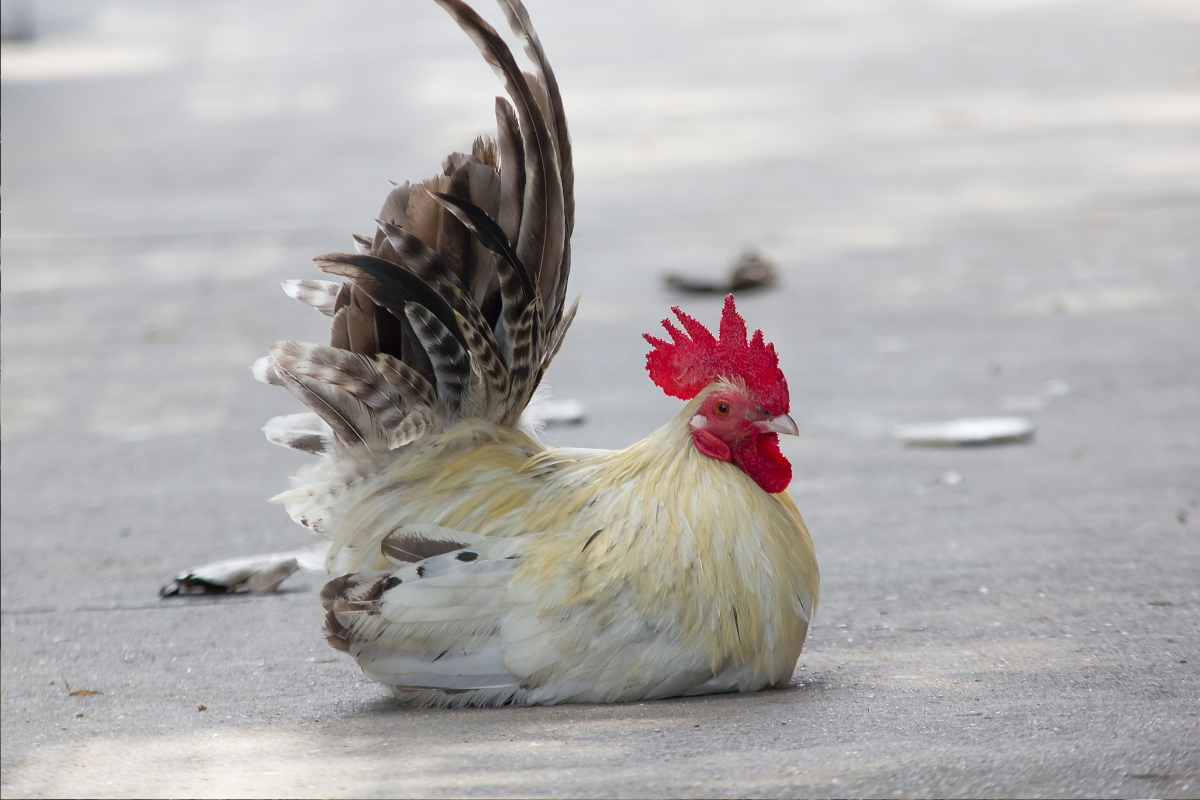
Nankin Bantam
The Nankin is a breed with history. It’s among the oldest of the true bantams, with some accounts saying that they were brought over to Britain in the 1500s! The Nankin likely originated in Southeast Asia and is named after the port of Nankin, where they might have been exported. The Nankin is the predecessor of many other bantam breeds.
These gentle little birds will win over your heart–they get along well with both other chickens and humans and are constantly exploring their surroundings. Nankins fare well in confinement and are handled easily, making them good for small spaces, but they like to fly. Other reasons to have a Nankin include their personality, which is friendly and curious, and their broodiness. They don’t lay many eggs of their own, but happily look after other chickens’ eggs as a brooder.
- Breed Name: Nankin
- Breed Type: Ornamental, brooder
- Temperament: Calm, happy, alert
- Size: Male 24 oz./ Female 22 oz.
- Eggs Per Year: 80-100
- Egg Size: Small
- Egg Color: White or cream
- Feather Type: Standard, with clean legs
- Comb Type: Single or rose comb
- Hardiness: Heat Tolerant
- Lifespan: 5-10 years
- Time To Maturity: 20-24 Weeks
Orpington Bantam
Orpingtons are the essential backyard chicken–easy to raise, easy to handle, hardy, friendly, and great layers. But what if you don’t have a backyard? If you have less space but want to own one of the most beginner-friendly birds out there, a bantam Orpington is a great choice. These puffy birds are as friendly as can be but are only a fraction of the size of a full-sized Orpington. They’re still decently large for a bantam breed, and their fluff makes them look substantial.
Orpington bantams are such lovable chickens and will give you as much love and attention as you give them. On top of that, they do perfectly well in confined spaces and are easily handled. Bantam Orpingtons are one of the best breeds if you don’t have much space.
- Breed Name: Orpington Bantam
- Breed Type: Layer, ornamental
- Temperament: Calm, docile, friendly
- Size: Hens 3 lbs, Roosters 3.5 lbs
- Eggs Per Year: 150-200
- Egg Size: Small
- Egg Color: Brown
- Feather Type: Standard, with clean legs
- Comb Type: Single Comb
- Hardiness: Cold hardy and heat tolerant
- Lifespan: 5-10 years
- Time To Maturity: 20 to 24 Weeks

Plymouth Rock Bantam
Plymouth Rocks are an iconic American breed and wonderful companions. This heritage breed of chicken has always captured the hearts of its fanciers. Bantam Plymouth Rocks are among the easiest chickens to raise, especially if you have limited space.
Naturally, the Plymouth Rock does not mind being in a smaller space or in confinement, and Plymouth Rock bantams are fine with only a little room. They’re unfussy, calm chickens that are very easy to keep and eager to please, not to mention they’re great with kids. While they’re not a meat bird like the large Plymouth Rock, Plymouth Rock bantams are still great layers of little brown eggs.
- Breed Name: Plymouth Rock Bantam
- Breed Type: Layer, ornamental
- Temperament: Gentle, easygoing, mellow
- Size: Hen: 2 lbs Rooster: 36 oz
- Eggs Per Year: 150-200
- Egg Size: Small
- Egg Color: Brown
- Feather Type: Standard with clean legs
- Comb Type: Single
- Hardiness: Cold hardy and heat tolerant
- Lifespan: 6-10 years
- Time To Maturity: 16-20 Weeks
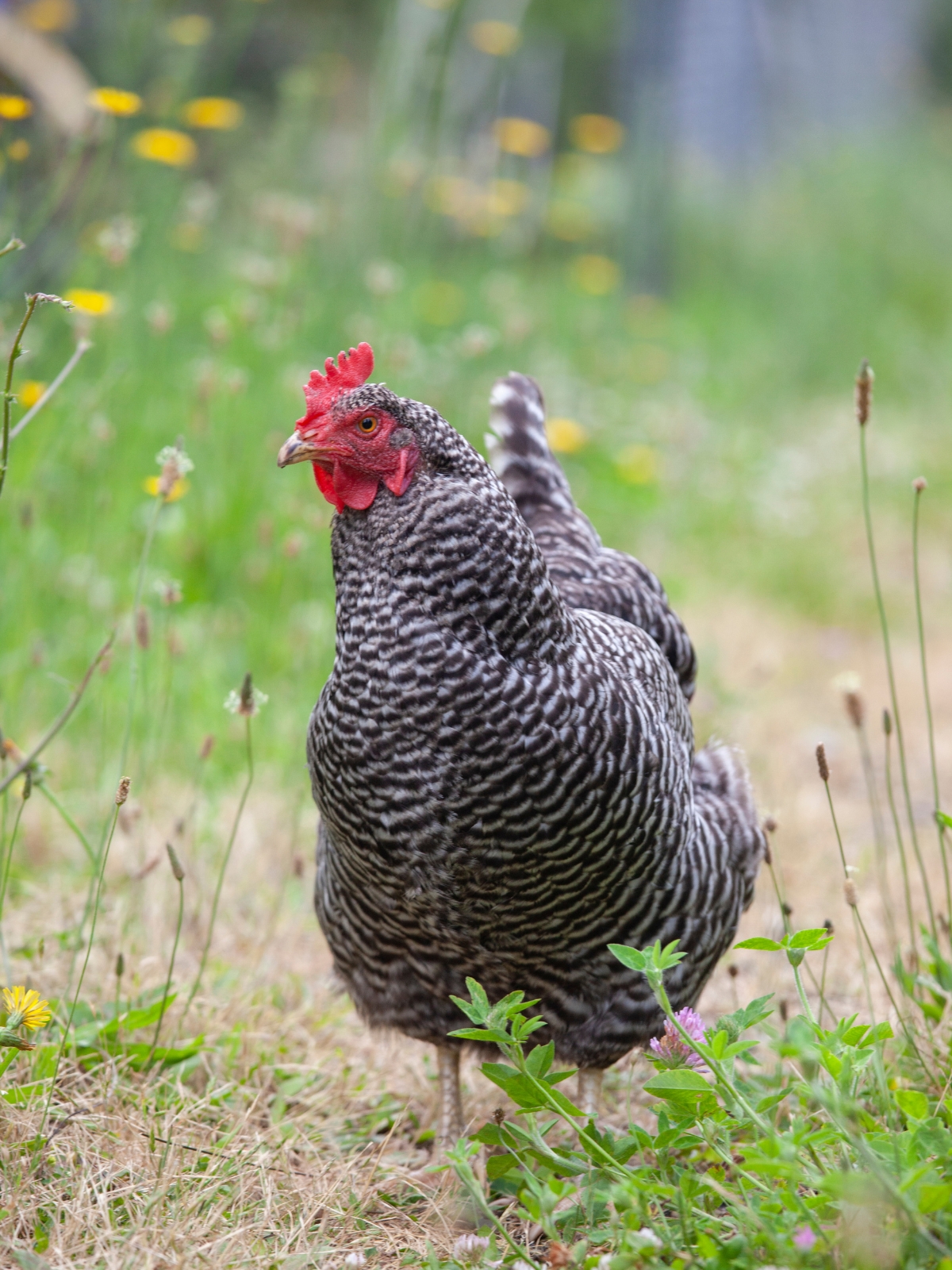
Polish Bantam
Polish chickens are one of the most unique-looking breeds out there, with their puffy hats, wild hairstyles, and the sought-after V-comb. They come in a rainbow of colors, too. If you want a house chicken that will start conversations (as if having a house chicken weren’t interesting enough already), go for a Polish chicken. Polish bantams are even more adorable and are equally as loving as a regular sized Polish, making them good housemates.
Personality-wise, Polish bantams can be a bit nervous if they can’t see under their feathers, but otherwise are the sweetest birds around. Because they’re ornamental birds, Polish bantams primarily for show, but they still lay a reasonably large number of eggs for a bantam. They’re also known for their broodiness, so they’ll happily hatch their own or others’ eggs.
- Breed Name: Polish bantam
- Breed Type: Ornamental, brooder
- Temperament: Cuddly, friendly, alert
- Size: Roosters 1.8 lbs, hens 1.6 lbs
- Eggs Per Year: 100-150
- Egg Size: Small
- Egg Color: White or cream
- Feather Type: Standard, clean legs. Can come in frizzle. Can have beards.
- Comb Type: V-Comb
- Hardiness: Not cold hardy
- Lifespan: 6-8 years
- Time To Maturity: 20 to 24 Weeks
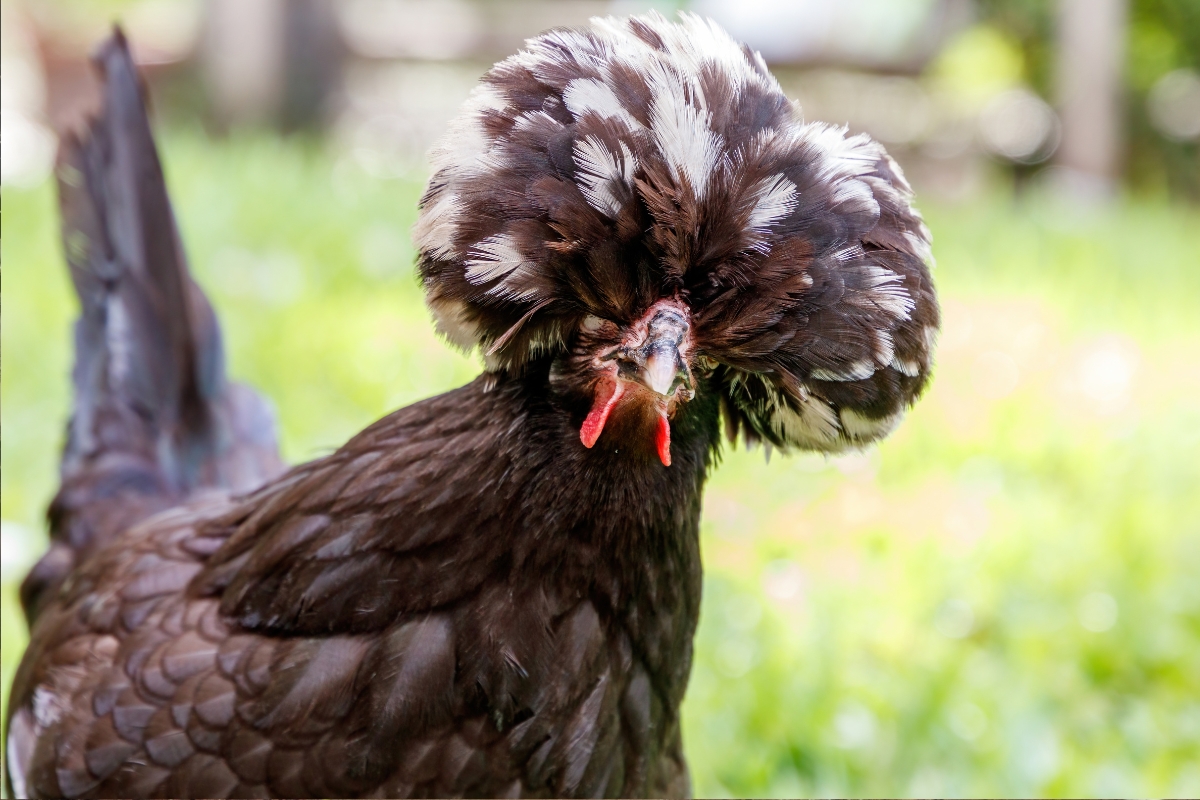
Rhode Island Red Bantam
A beloved layer breed that formed the basis of today’s egg industry, Rhode Island Reds are an institution. These iconic red chickens, with their rusty-hued feathers and bright yellow skin, are known for their egg production. These powerhouses come in a miniature size, so be prepared for lots of small eggs! Rhode Island Red bantams are hardy and easy to keep, especially in confinement.
A bantam Rhode Island Red is independent, curious, and active, and they pour their energy into whatever they’re doing, whether that be getting the attention of their owners or looking for bugs. Roosters can be protective of their flock, but otherwise, Rhode Island Red bantams are generally agreeable birds. They’re a great breed for if you have a small space but prioritize eggs.
- Breed Name: Rhode Island Red Bantam
- Breed Type: Layer, ornamental
- Temperament: Curious, alert, active
- Size: Hens 1.85 lbs, roosters 2.2 lbs
- Eggs Per Year: 150-200
- Egg Size: Small
- Egg Color: Brown
- Feather Type: Standard, clean legs
- Comb Type: Single Comb
- Hardiness: Cold Hardy and Heat Tolerant
- Lifespan: 6-8 years
- Time To Maturity: 18 to 20 Weeks
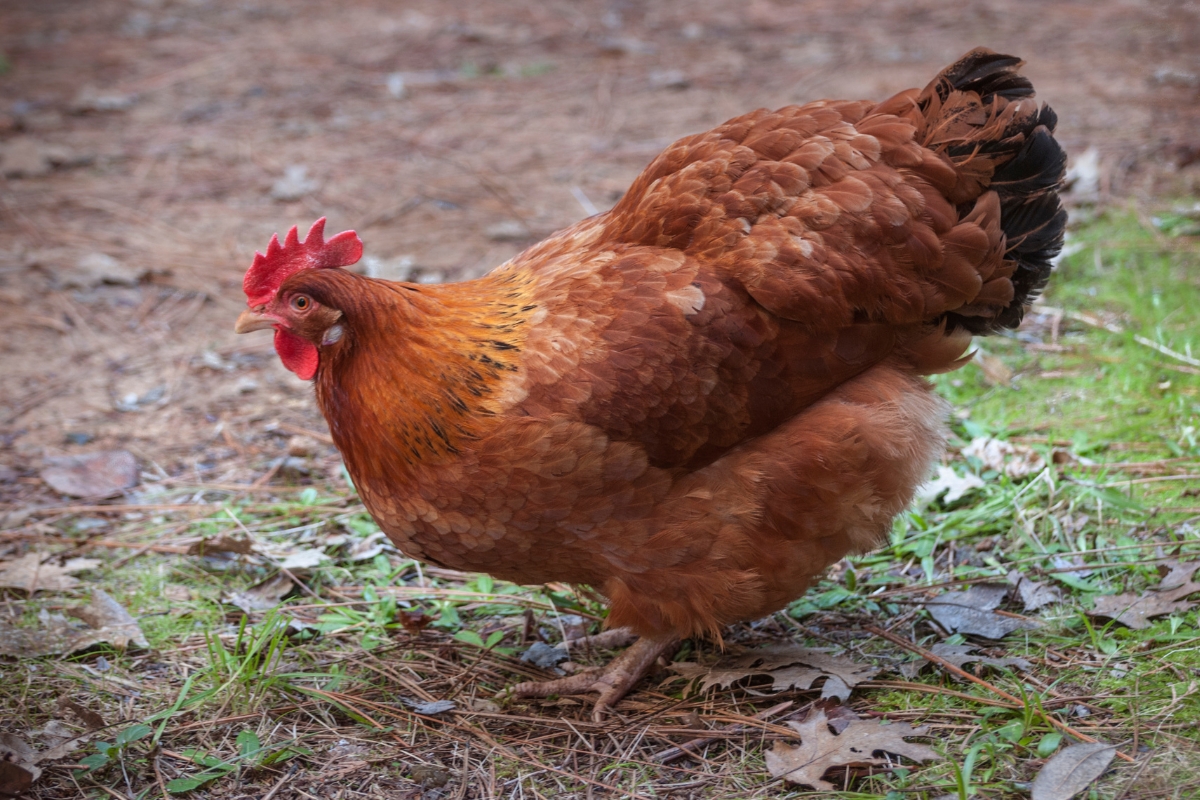
Rosecomb Bantam
The Rosecomb chicken is a punch of personality in a tiny package. Rosecombs are spectacular show birds that come in over twenty-five recognized colors. Most striking is their white earlobes, and signature rose comb.
In terms of personality, a Rosecomb’s confidence is off the charts. Rosecombs are great if you want an active chicken to keep you company. They’re also very easy to handle, due to their easygoing personalities and small stature. The roosters can be a bit protective of their flock. Not only are they compact, but they are also thrifty foragers, making them great for saving money on feed.
- Breed Name: Rosecomb
- Breed Type: Ornamental
- Temperament: Friendly, active, confident
- Size: Roosters 1.6 lbs, hens 1.3 lbs
- Eggs Per Year: 50-100
- Egg Size: Small
- Egg Color: White
- Feather Type: Standard with clean legs
- Comb Type: Rose comb
- Hardiness: Not hardy
- Lifespan: 7-8 years
- Time To Maturity: 20 to 24 Weeks
Serama
The smallest breed of bantam chicken, the Serama is the ultimate bantam chicken if you’re looking for something compact, stately, and friendly. They come in a number of different sizes, according to the American Bantam Association, all of which are very small–the largest Seramas are under 2 pounds! Seramas have a very distinct look to them–they stand upright and have a very dignified appearance.
They were bred to resemble toy soldiers. Their confident frame reflects their personalities as proud show birds. Despite looking serious, Seramas are extremely friendly and love their owners. Some Seramas are also surprisingly good layers, and certain bloodlines can produce 180-200 eggs per year! Seramas do well in small spaces, especially the smallest varieties, and are a great choice if you want an affectionate companion that does well in heat.
- Breed Name: Serama
- Breed Type: Ornamental, layer
- Temperament: Lively, outgoing, confident
- Size: 0.5-1.2 lbs
- Eggs Per Year: 180-200
- Egg Size: Tiny
- Egg Color: Brown or white
- Feather Type: Standard, clean legs
- Comb Type: Single
- Hardiness: Heat-tolerant
- Lifespan: 7-10 years
- Time To Maturity: 15-18 weeks
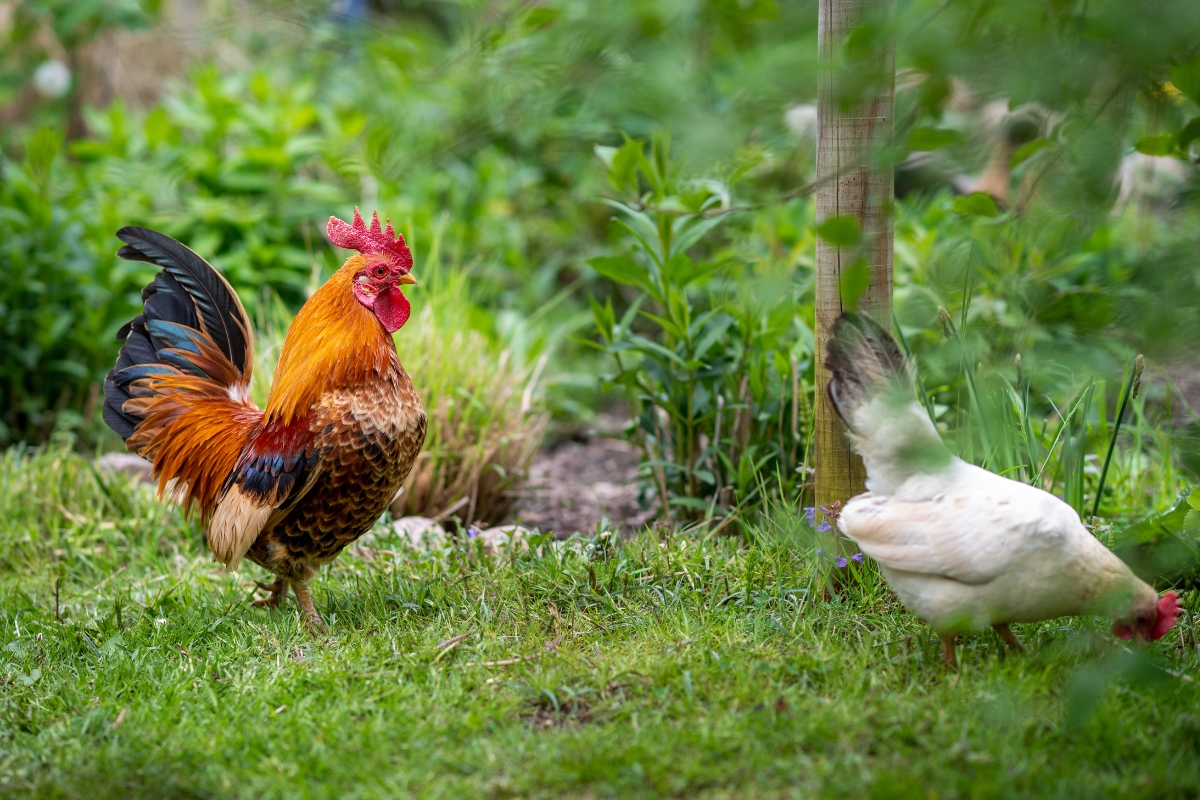
Silkie Bantam
The beloved Silkie is one of the most popular house chickens, and understandably so. They’ve captured the hearts of countless people with their downy plumage and affectionate demeanor. To add to their cuteness, silkies come in a miniature variety!
Bantam silkies are great for people with small yards, as they don’t need much space to live a perfectly happy life. Your Silkie bantam will follow you around like a puppy, asking for attention and treats. They love being cuddled. There are plenty of reasons to own a silkie, and you can read more here.
- Breed Name: Silkie
- Breed Type: Ornamental
- Temperament: Cuddly, affectionate, friendly
- Size: Hens 2 lbs and Roosters 2.2 lbs
- Eggs Per Year: 80-120
- Egg Size: Small
- Egg Color: White or cream
- Feather Type: Fluff, no hard feathers, feathered legs. Come in bearded and non-bearded varieties.
- Comb Type: Walnut
- Hardiness: Fairly cold-hardy
- Lifespan: 7-9 years
- Time To Maturity: 24-30 Weeks

Sussex Bantam
Known for their affectionate personalities, ease of care, and egg-laying potential, Sussex chickens are a very popular breed for backyard chicken owners. If you have a bit less room but still want this lovely heritage breed, worry not! Sussex bantams are equally as wonderful as a large Sussex.
They’re great at laying eggs, and although they’re not as good at being table birds as a full-size Sussex, they’ll make up for it by being perfect companions that are easy to care for. A bantam Sussex is really easy to handle and will happily be picked up. They’re happy to share a small space with you.
- Breed Name: Sussex
- Breed Type: Layer, ornamental
- Temperament: Docile, friendly, easygoing
- Size: Hens 2.4 lbs, roosters 3.3 lbs
- Eggs Per Year: 150-200
- Egg Size: Small
- Egg Color: Light brown
- Feather Type: Standard, with clean legs
- Comb Type: Single Comb
- Hardiness: Cold Hardy, and Heat Tolerant
- Lifespan: 8-10 years
- Time To Maturity: 20 to 24 Weeks
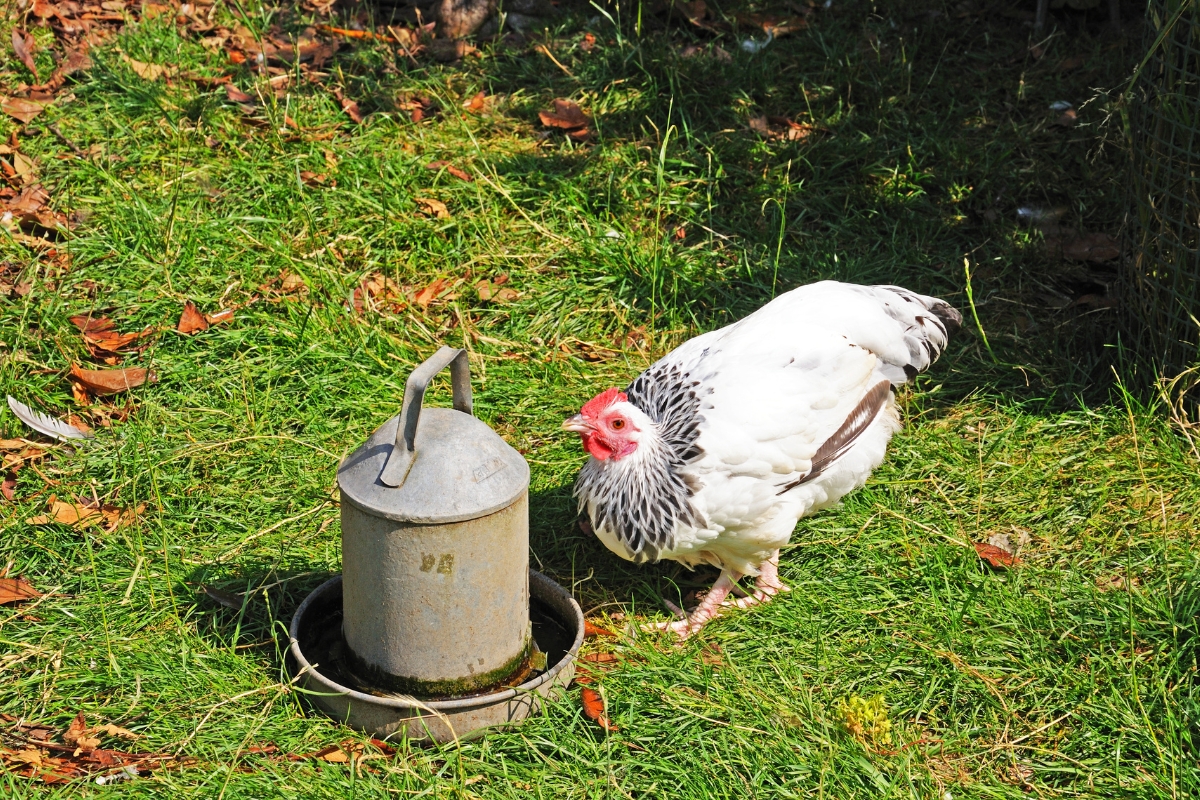
Wyandotte Bantam
Robust, hardworking, and adaptable–the Wyandotte bantam is it all. Wyandottes come in some very pretty patterns, exhibiting gorgeous lacing and vibrant colors, and the bantams are just as eye-catching. The bantam Wyandotte is mostly kept as an ornamental bird but is a productive layer, producing about 150 small brown eggs per year–no small feat for a bantam!
Bantam wyandottes are hardy, faring well in any space at a variety of temperatures. They’re also friendly and independent and don’t constantly ask for attention, but are happy to be around their owners in small spaces.
- Breed Name: Wyandotte bantam
- Breed Type: Ornamental, layer
- Temperament: Independent, confident
- Size: Hens 1.6 lbs, roosters 1.8 lbs
- Eggs Per Year: 150-200
- Egg Size: Small
- Egg Color: Brown
- Feather Type: Standard, clean legs
- Comb Type: Pea Comb
- Hardiness: Cold Hardy and Heat Tolerant
- Lifespan: 7-8 years
- Time To Maturity: 20 to 24 Weeks
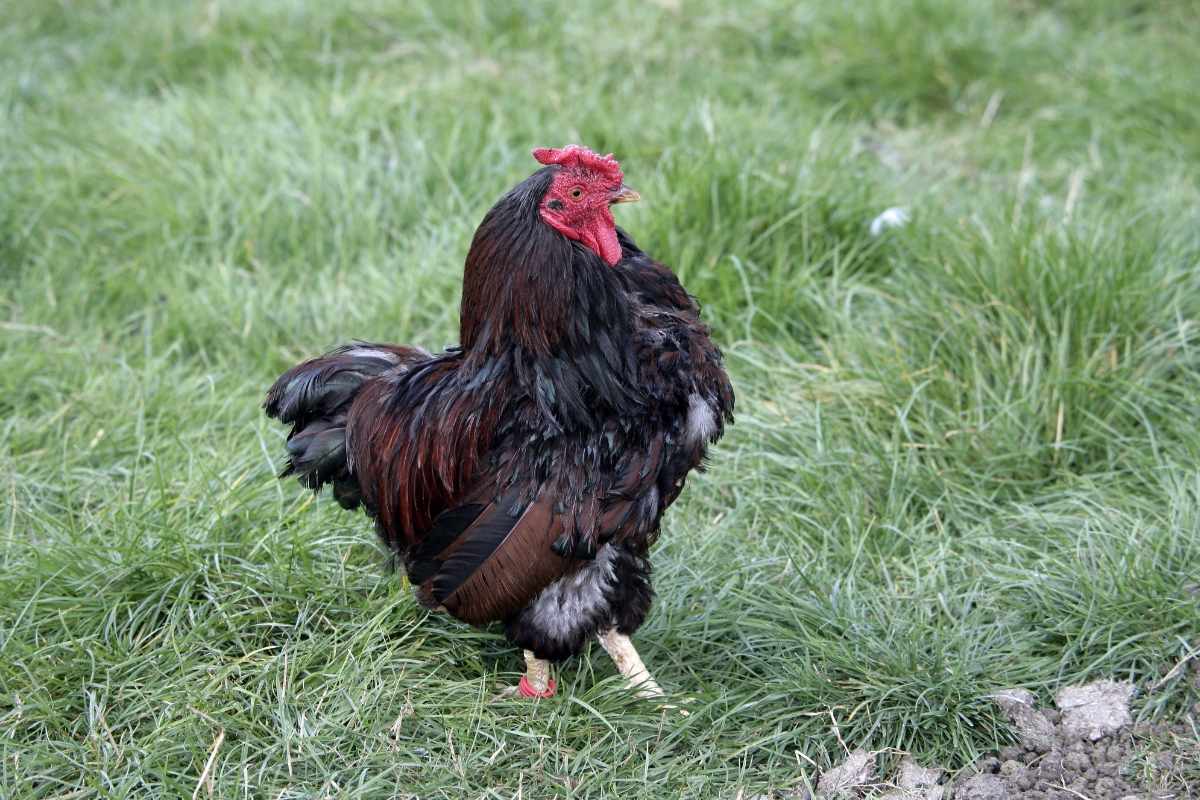
Chicken Breed Guides
Looking for more chicken breed guides?
- Best Egg Laying Chickens Breeds for Beginners
- Chickens that Lay Colorful Eggs
- Cold Hardy Chicken Breeds
- Fluffy Chicken Breeds
- Best Broody Chicken Breeds for a Self-Maintaining Flock
- Chickens That Lay the Most Eggs
- Best Dual Purpose Chicken Breeds
